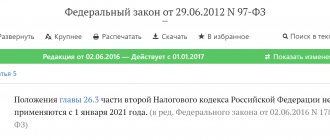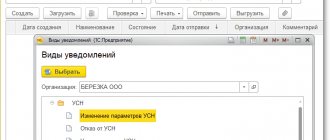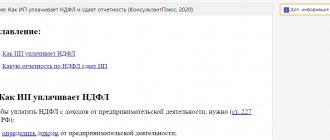In practice, there are cases when heads of enterprises and organizations decide to switch from the simplified taxation system (STS) to the Unified Tax on Imputed Income (UTII). And the first thing these managers face is the question of how to correctly implement the planned actions.
From this article you will learn about the general provisions in accordance with which such changes are implemented, as well as when such a step can be taken, where to apply, what are the consequences of changing the simplified tax system to UTII, what is the procedure and features of such changes, and the possibility of combining two fiscal regulations.
How to become a payer of the simplified tax system
A company or individual entrepreneur can become a “simplified” if it meets the following requirements (Article 346.12 of the Tax Code of the Russian Federation):
- The amount of income for the 9-month period of the year preceding the year in which the simplified tax system began to be applied is less than 112.5 million rubles. (criterion for organizations only). For example, if the transition is planned from 2021, the company’s income from January to September 2021 cannot exceed the specified amount.
NOTE! This income limitation is provided only for organizations. Individual entrepreneurs can switch to the simplified tax system for any amount of income, but in the future they must comply with the revenue limit of 150 million rubles. in a year.
- The average number of employees is no more than 100.
- The residual value of fixed assets is no more than 150 million rubles.
NOTE! This requirement applies to both companies and individual entrepreneurs.
- The percentage of participation in the organization of another taxpayer-legal entity is less than 25%.
- The payer category is not reflected in subparagraph. 1–13 p. 3 art. 346.12 Tax Code of the Russian Federation.
According to the requirements of Art. 346.13 of the Tax Code of the Russian Federation, in order to switch to the simplified tax system, an application should be sent to the tax authority with which the company or individual entrepreneur is registered:
- before December 31 of the year preceding the transfer, or
- within 30 calendar days - for newly registered payers.
For more information on how to become a payer on the simplified tax system, see the material “Who are the payers of the simplified tax system?” .
Where to pay tax under the simplified tax system if an individual entrepreneur does not work at his place of registration, find out here.
Where to apply for transfer
The application must be submitted to the INFS. In this case, you need to proceed from the specific location of the objects for which the fee will be paid. So, if the objects are located on the territory of one district or urban district, you must submit an application to the tax service on whose territory the place where you conduct this activity is located. The same applies to objects that are located on the territory of several districts in St. Petersburg or Moscow. If the facilities where activities are carried out are located on the territory of several districts or city districts, in 2021 applications will have to be submitted to each INFS branch located in the same territory as the facilities where these activities are carried out.
How to become a UTII payer
IMPORTANT! UTII cannot be used from 2021. It has been canceled throughout the Russian Federation. A number of regions abandoned the special regime already in 2020. See here for details.
The procedure for transition to imputation is specified in Art. 346.28 of the Tax Code of the Russian Federation and provides for:
- registration at the place of activity (or registration) of the company or individual entrepreneur;
- submitting a notice of transition to UTII no later than 5 days from the date of commencement of UTII application.
ConsultantPlus experts explained whether it is possible to switch to UTII in mid-2021 and answered the most common questions from taxpayers:
If you don't have access to the system, get a free trial online.
UTII payers can provide the following types of services:
- of a domestic nature;
- veterinary;
- repair and maintenance of cars and motorcycles;
- on the organization of parking lots;
- catering (the area of the premises should not exceed 150 sq. m);
- retail sale of food and non-food products (maximum area limitation - 150 sq. m);
- for transportation by road;
- outdoor advertising on special structures or on vehicles;
- leasing buildings and land plots for retail chains;
- for the placement and residence of people in an area of no more than 500 square meters. m.
Read more about the procedure for registering as a UTII payer here.
Tax amount calculation
The single tax on imputed income for 30 days is calculated using a certain formula. It is necessary to multiply the amount of the basic yield by the physical indicator, then multiply by the deflator coefficient and by the adjustment coefficient. The resulting number must be multiplied by 15%.
Basic profitability is a value that is set by the state for each type of activity. Similar to this indicator, each type of business activity has its own physical indicator. In 2021, the deflator coefficient is 1.798. The correction coefficient is determined by government officials in each region. This value is set to reduce the tax amount. You can find out what adjustment coefficient is set this year for a specific region on the official website of the Federal Tax Service. 15% is the maximum value. In general, this value varies depending on the specific type of activity and the category to which the taxpayer belongs, and can range from 7.5% to 15%.
How to switch from simplified tax system to UTII
The transition from simplified tax system to UTII (here we are talking about replacing one mode with another, without combining, which we will talk about below) is carried out in the following ways:
- At the end of the year in which the taxpayer lawfully applied the simplified tax system. To do this, you must meet 2 deadlines. Before January 15 of the year following the year of application of the simplified tax system, the Federal Tax Service must be notified of the refusal to use this system. What happens if such notice is not submitted, see here. At the same time, no later than 5 working days from the date of commencement of application of UTII, you must inform the Federal Tax Service about this circumstance (see forms for individual entrepreneurs and for organizations). Accordingly, if you intend to apply UTII instead of the simplified tax system from the beginning of the year, you must submit both applications in compliance with both established deadlines. Such a transition cannot be made during the year, since there is an obligation to apply the simplified tax system throughout the entire tax period, unless the right to use this regime is lost.
- In case of loss of the right to use the simplified tax system during the year due to non-compliance with the requirements of Art. 346.12 of the Tax Code of the Russian Federation (these include both termination of compliance with the above requirements and exceeding the maximum allowable limit of possible income for the simplified tax system of 150 million rubles), the payer must stop charging tax under this system from the beginning of the quarter in which this occurred. The Federal Tax Service must be notified of this fact within 15 days following the quarter of loss. From the quarter of loss until the end of the year, taxes should be calculated in the manner in force for OSNO, since the Tax Code of the Russian Federation does not provide for the possibility of replacing the simplified tax with UTII before the end of the year in the event of loss of the right to the simplified tax system. If you intend and have the opportunity to apply UTII at the end of the year in which the right to the simplified tax system was lost, you must report this to the Federal Tax Service within 5 working days from January 1 of the year following the year of loss.
The form of notification of refusal to use the simplified tax system is contained in the order of the Federal Tax Service of Russia dated November 2, 2012 No. ММВ-7-3/ [email protected]
It should also be noted that, by virtue of the norms of paragraph 7 of Art. 346.13 of the Tax Code of the Russian Federation, in the event of a transition to UTII from the simplified tax system back to the simplified tax system, the taxpayer can only transfer one year after the transition from the simplified tax system.
Is it possible to reduce the single tax on imputed income?
In 2021, individual entrepreneurs have the right to reduce this amount by the amount of insurance premiums paid in each tax quarter. We are talking about entrepreneurs who operate without other employees and pay contributions for themselves. In this case, the entrepreneur has the right to independently choose the schedule for paying contributions.
It is only important that this amount be transferred in a timely manner within one year. In 2021, it became possible to use overpaid contributions in any subsequent quarter. For example, contributions that were paid in the second quarter are allowed to be used to reduce taxes in the third quarter.
In addition, this taxation system provides an opportunity to reduce taxes for employees in the organization. It is permissible to reduce the amount to 50% (and for individual entrepreneurs without employees - up to 100%). At the same time, tax reduction is possible only in those quarters in which the organization or individual entrepreneur had other employees. According to the latest news, next year this 50% will be allowed to include not only contributions paid for employees, but also for individual entrepreneurs.
Is it possible to combine simplified taxation system and UTII?
The Tax Code of the Russian Federation does not contain a ban on the simultaneous use of both regimes; Moreover, if the taxpayer calculates UTII for some types of activity, then the simplified tax system applies to all other types of activity (that is, there is no need to formalize withdrawal from simplified taxation). However, when combining these 2 modes, an individual entrepreneur or company must maintain separate records.
For more information about separate accounting, see the material “Separate accounting under the simplified tax system and UTII: maintenance procedure” .
About the nuances of these tax regimes, see the material “UTII or simplified tax system: which is better - imputation or simplified taxation?” .
Are you switching from UTII? Connect Kontur.Accounting
45% discount in November: RUR 7,590 instead of 13,800 rub. per year of work
Easy bookkeeping
The system itself will calculate taxes and remind you of the deadlines for payments and submission of reports.
Automatic calculation of salaries, vacation pay and sick leave
Technical support 24/7, tips inside the service, reference and legal database
Sending reports via the Internet
Reports and KUDiR are generated automatically based on accounting data
Electronic document management and quick verification of counterparties
Documents, transactions, analytical reports, VAT reconciliation
There is a list of circumstances when the use of UTII is unacceptable. According to current legislation, the transition to imputation is not possible for companies that:
- organize catering in hospitals, schools and other institutions where this service is mandatory;
- not only sell products, but also engage in their production;
- It is also impossible to switch to UTII for companies and individual entrepreneurs that lease premises or land plots at gas stations, as well as lease land for the placement of retail facilities on it.
The transition to imputation occurs either voluntarily in the general order, or due to failure to fulfill the conditions for the simplified tax system. Let's consider these options in more detail.
Features of the transition from simplified to imputation
Due to some differences in accounting for income and expenses in a simplified manner, there are a number of features that you should definitely pay attention to when switching to UTII.
Let's consider several situations that taxpayers may encounter:
Situation 1
The taxpayer, using the simplified tax system, sold products for which payment was received while on UTII. What to pay - tax according to UTII or according to the simplified tax system?
There is no need to pay a simplified tax; you only need to pay UTII for the period of sale.
See also: “How to take into account for the simplified tax system goods purchased in the “imputed” period?”
Situation 2
The taxpayer received an advance payment during the period of being on the simplified tax system, and the implementation was reflected in the period of application of UTII. What should I pay - imputed or simplified tax?
You must pay tax according to the simplified tax system for the period in which the funds were received.
Situation 3
A taxpayer using the simplified tax system, not being a VAT payer, as a general rule usually does not use accounts 19 “Input VAT” and 68.2 “Accrued VAT” in accounting. Do I need to pay VAT when switching to imputation?
A taxpayer using UTII also does not have to pay VAT. There will be 2 situations as exceptions for both him and the simplified tax system payer:
- He is a tax agent for VAT.
- He issued a VAT invoice.
In both cases, non-payers of this tax must pay it to the budget. Therefore, when applying both the simplified tax system and UTII, the tax that needs to be paid will appear in account 68.2. In this case, account 19 will not be used, since tax evaders do not have the right to deduction.
For more information about the peculiarities of the work of VAT payers and non-payers, see the material “Basic rules when an organization without VAT works with an organization with VAT” .
Carry-over income: payment under one taxation regime, and sale under another
When describing the situation with such income, we mean a situation where payment is made under one regime, and sales under another. When working on UTII, a situation in which the shipment of goods occurs with a temporary gap in payment is extremely rare, since in relation to trading activities only retail trade can be transferred to UTII. Therefore, here and further, when talking about carryover operations, we will not talk about the shipment of goods, but about the provision of services.
Transition from UTII: where to go and what to do
So, let's consider the question: how to take into account income received after the transition to the simplified tax system, if the service itself was provided during the application of UTII?
Unfortunately, there is no specific procedure for accounting for income from sales in connection with the transition from the “imputed” system to the simplified one in the Tax Code.
If we turn directly to Chapter 26.2 of the Tax Code of the Russian Federation, then the date of receipt of income from simplifiers is the moment of payment (cash method). In this regard, we can conclude that if payment is received during the period of application of the simplified tax system, then it should be included in taxable income under the simplified tax system. But, on the other hand, the operation itself to provide the service occurs during the period of application of UTII. Therefore, it would be logical that the proceeds from this operation would not be included in the income taxed under the simplified tax system.
As we see, the situation is not clear-cut. And even the officials themselves do not fully understand how to deal with this situation, first giving one explanation, then the exact opposite. Thus, in letters from the Ministry of Finance dated 04/01/2019 No. 03-11-11/22190, dated 08/21/2013 No. 03-11-06/2/34243, they said that the revenue received under the simplified tax system for services provided under UTII there is no need to include it in the database when simplifying. But later they changed their minds (letter from the Ministry of Finance dated December 24, 2019 No. 03-11-11/101022). Thus, the latest clarifications from financiers are not in favor of taxpayers.
But the Federal Tax Service of Russia has shown itself to be loyal to payers. In their only explanation on this topic, the tax authorities indicated that “ if the sale of goods (work, services) was carried out during the period of application of UTII, then the income from the sale of these goods (work, services) received by the taxpayer during the period of application of the simplified tax system, when determining the tax base according to STS are not taken into account
"(letter dated October 27, 2020 No. SD-4-3/ [email protected] ).
Therefore, if you receive revenue from last year’s services next year, keep in mind that, unfortunately, there is no clear explanation today as to whether it should be subject to a “simplified” tax. But, given that in any case, taxpayers are audited by tax inspectorates, it is unlikely that during an audit they will express a position that contradicts the approach of their higher department. Therefore, when choosing decisions, adhering to the opinion of tax authorities is the least risky.
Now let's consider the situation when payment is received during the UTII period, and the service will be provided during the period of application of the simplified tax system. Do additional tax obligations arise in this case?
There is only one official explanation from the Ministry of Finance on this matter (letter dated July 3, 2015 No. 03-11-06/2/38727), from which it follows that the amount of the advance in such a situation does not need to be included in simplified income. Thus, such a service will not be subject to taxation under the simplified tax system.
Transition from UTII to OSNO: what to do with VAT and income tax
The procedure for filling out reports on the simplified tax system and UTII
If a taxpayer, having decided to switch to UTII for certain types of activities, applies the simplified tax system and UTII in parallel, he will have to fill out the appropriate declaration for each type of activity and pay taxes to the budget.
The form of declaration under the simplified tax system is established by order of the Federal Tax Service of Russia dated February 26, 2016 No. ММВ-7-3/ [email protected] ; At the same time, you should pay attention to the fact that for the objects “income” and “income minus expenses” the procedure for filling out the declaration is slightly different.
In accordance with Art. 346.23 of the Tax Code of the Russian Federation, organizations send reports to the tax authority according to the simplified tax system until March 31 after the end of the year, individual entrepreneurs - before April 30. However, in certain situations, the simplified tax system declaration should be submitted earlier: before the 25th day of the month following the one in which the activity on the simplified tax system was terminated at the initiative of the taxpayer, and before the 25th day of the month following the quarter of termination due to loss of the right to be in the specified regime .
Advance payments are due by the 25th day of the month of the next quarter. Payment of the simplified tax at the end of the year is made within the reporting deadlines.
This material will help you fill out the simplified tax return correctly.
Now about what concerns reporting on UTII. Currently, the declaration form is in force, approved by order of the Federal Tax Service dated June 26, 2018 No. ММВ-7-3/ [email protected]
For a sample of filling out a declaration using the new form, see here.
The deadline for submitting the declaration is regulated by clause 3 of Art. 346.32 of the Tax Code of the Russian Federation - no later than the 20th day of the month following the expired quarter.
Payment of UTII, according to clause 1 of Art. 346.32 of the Tax Code of the Russian Federation, is carried out before the 25th day of the month following the expired quarter.
Transition nuances
Although UTII and the simplified tax system are somewhat similar to each other, the periods of their application should be distinguished, especially when the transition from one regime to another did not take place since the beginning of the year.
It is also important to choose the right tax object: when switching from UTII to the simplified tax system, the expenses of the individual entrepreneur will reduce the tax base when choosing the object “income minus expenses”, and when choosing the object “income”, expenses are not important. You cannot change the selected object until the end of the year.
Combining both modes, you will have to fill out and submit the appropriate declaration for each of them, pay taxes, and keep separate records.
Individual entrepreneurs are not required to keep accounting, but if they do, then they should prepare and formalize the transition from UTII to the simplified tax system in 1C or another accounting program used.
Results
When switching from the simplified tax system to UTII, the taxpayer must promptly notify the tax authority about this in order to avoid unpleasant consequences. Despite the fact that the simplified tax system and UTII are similar in some aspects, for a correct transition from one special regime to another, it is necessary to correctly distinguish between the periods of application of the simplified tax system and UTII.
And don’t forget that 2021 is the last year when you can work on UTII. And not everyone. We talked about the abolition of imputation here.
Sources:
- Tax Code of the Russian Federation
- Order of the Federal Tax Service of Russia dated November 2, 2012 No. ММВ-7-3/ [email protected]
- Order of the Federal Tax Service of Russia dated June 26, 2018 No. ММВ-7-3/ [email protected]
You can find more complete information on the topic in ConsultantPlus. Free trial access to the system for 2 days.
When can I go?
If you familiarize yourself with the requirements of the Tax Code of the Russian Federation, then according to paragraph 346.28, in the case when the taxpayer pays fees using imputed income, then in this case the transition is possible only from the beginning of the next year.
However, it should be taken into account that in order to change the taxation procedure, timely submission of an application is necessary. The deadline for submitting such an application to the fiscal service at the place of registration of the enterprise is set as no later than January 15.
There are times when entrepreneurs want to apply UTII to a new line of work. In this case, the application can be submitted at any time. Then the two tax systems will be combined.
If an individual entrepreneur previously worked for OSNO, then he can also declare preferences regarding the specified fiscal regime at any time.
The State Duma wants to abandon the “fixed size”
If we talk about UTII, then in 2021 changes in the latest news say that the State Duma wants to consider a new law according to which the deflator coefficient will increase annually, next year the authorities want to set the size to 1.891, in 2021 it should increase by 10%, and in 2021 - 14.7%. However, for now the authorities have set the deflator at this year’s level, equal to 1.798. Let us recall that the Government almost every year considers the possibility of increasing the deflator, but this requires an economic justification, which “at the top” cannot yet clearly formulate.
Will UTII be canceled in the near future?
Every year the authorities raise the question of the appropriateness of the above type of taxation, but now the payment of UTII has been extended until 2021. Even that year, officials wanted to abolish the imputed tax by 2021, but left the decision “until better times.” The government decided to support small businesses in a difficult economic situation.
Every year the number of individual entrepreneurs and LLCs that switch to this type of tax is growing; now their number is approximately 2 million and 500 thousand, respectively. Now it is small businesses that develop the economy of our country, and self-employed citizens help solve the issue of unemployment.
There are also opponents of this tax, believing that local budgets lose significant amounts. However, UTII is characterized by the rapid development of entrepreneurship; the abolished tax will discourage many citizens from engaging in commercial activities.










